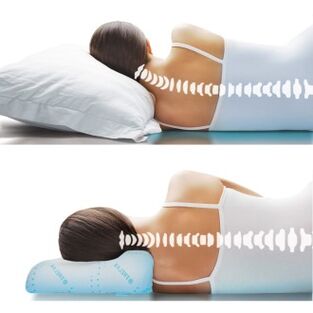
Column diseases are unpleasant in themselves, but represent the greatest danger if they affect the cervical region.
Even a seemingly harmless pathology asOsteochondrosis of the cervical region, can cause the appearance of headaches, difficulty in blood circulation, the deteriorated work of the internal organs.
In the absence of treatment, osteochondrosis can lead to the development of other more serious diseases.
To avoid this result, you must carefully monitor your health and see a doctor when the first symptoms of osteochondrosis appear.
Fortunately, modern medicine has methods that allow this disease to quickly and effectively treat this disease.
What is
Cervical osteochondrosis is a pathology in whichThe soft intervertebral pulp becomes a bare fabric.In addition, blood vessels and nerve roots are involved in pathogenesis.The osteochondrosis of the cervical region has the ability to disguise several disorders.
Clinical image
A distinctive characteristic of cervical osteochondrosis is the pain in the neck, the head, the upper back.Patients may complain about dizziness, lack of air, jump into blood pressure, nausea, numbness of the tongue, loss of consciousness.They often suspect angina pectoralis and other diseases of the cardiovascular system.
Classification
The classification of cervical osteochondrosis can be relative to the degree of disease development:
- 1 grade - Degenerative changes - distributions on intervertebral discs are produced;
- 2 degrees: the vertebrae themselves are subject to changes;
- 3 degrees - intervertebral hernias appear.
Prevalence and meaning
The osteochondrosis of the cervical column "becomes younger" literally before our eyes.An examination of patients of different ages that tend to osteochondrosis showed that in current young problems with the column they arise much earlier (sometimes the first symptoms of the disease appear in adolescence) that the representatives of the previous generation of the family.
People who were born 60-70 years communicate with clinics about osteochondrosis of mature age and old age, although the people who were born 20-40 years ago tire of osteochondrosis even at an early age.This trend is evidence of a significant deterioration in the health of young generation caused by a decrease in nutrition quality and a sedentary lifestyle.
The clinical manifestations of osteochondrosis are found in approximately 60 percent of adults living in European countries.It is observed that women obtain cervical osteochondrosis in 50-55 years and men from 45 to 50 years.
Risk factors
The possibilities of increasing osteochondrosis if available:
- abnormalities of column development;
- overweight;
- long physical effort;
- bad habits (smoking);
- sedentary lifestyle;
- work, which implies the regular vibration impact on the spine (for example, with vehicle drivers);
- long stress, excessive nerve tension;
- local hypothermia;
- previous lesions in the neck and neck;
- Autoimmune pathologies that imply the degeneration of the cartilage.
Reasons
The main reasons for the development of osteochondrosis include:
- genetic predisposition;
- disturbed metabolic process;
- Weak physical development.
It is difficult to establish the exact cause of the appearance and development of cervical osteochondrosis, because this disease occurs in young and old people involved in sports and leading a sedentary lifestyle.
Psychosomatic
The development of cervical osteochondrosis indicates the inability to resist problems competently.Sometimes people become so strong and safe in their skills that their stability before adversity is transformed into stiffness and lack of flexibility.In this case, attempts to touch the head are accompanied by rigidity, seizures and other unpleasant sensations.
In addition, osteochondrosis can develop in people who are afraid of problems and do not know how to deal with them.In this case, the mammal protective reflex is activated, and the head is literally drawn on the shoulders.This provision is considered unnatural, therefore, after some time, the muscles of the cervical region begin to hurt and deform.
Consequences
Decrease in muscle elasticity and joint flexibility- Signs of natural aging of the body.However, in patients with osteochondrosis, they appear long before in healthy people.Osteochondrosis can cause the development of migraines, hypertension, respiratory system diseases, spinal cord ischemia and brain accident, etc.
Inappropriate treatment of osteochondrosis is no less dangerousAs a lack of treatment.The inept actions of a doctor can lead to persistent deterioration in a sudden disability or.
Diagnostic symptoms and methods
The main signs of osteochondrosis of the cervical region include:
- Pain on the back of the head, neck, arm and shoulder, which intensify when sneezing, coughing and minimal load in the arm;
- burning among the shoulder blades, tingling in legs or arms, numbness;
- pain and crunch on the neck that occur during the inclination and the turns of the head;
- fatigue, weakness;
- fainting and dizziness derived from acute turns of the head;
- The headaches, which generally begin on the back of the head, extend to temples and crown.
Other signs of cervical osteochondrosis include noise in the ears, auditory disability and a decrease in visual acuity.Sometimes, the disease is felt by pulling pains in the area of the heart.
In the first signs of cervical osteochondrosis, you must consult a doctor who will perform a comprehensive exam, will diagnose.In this case, diagnostic methods such as magnetic resonance, laboratory studies, ultrasound, ECG.
Treatment
The treatment of cervical osteochondrosis depends on the stage of the disease.If in the first stage there is a sufficiently conservative and wandering treatment, then in the second and third stage, the doctor's task is, in the first place, to stop pain syndrome.Improved cases may require surgical treatment for decompression and stabilization of vertebrae.
Drugs
People with osteochondrosis of the cervical region can be prescribed:
| Cluster | Description |
| NSAID (non -steroidal anti -inflammatory drugs) | It helps eliminate swelling and pain. |
| Vasodilatative drugs | Contribute to improving blood circulation. |
| Sedatives, muscle relaxants | They are prescribed additionally to facilitate the general condition of the patient and reduce the doses of the NSAIDs.Relieve nerve and muscle cramps at the same time, help achieve a better therapeutic effect. |
At the end of the therapy course, NSAIDs should be purchased for a first -aid kit for the home, because neck pain can be returned periodically (with stress, excessive excess, weather change).Before taking any drug, consult your doctor.
Surgical treatment
If a positive effect is not observed after a conservative treatment of a conservative treatment, the doctor may recommend the patient's spinal fuse.This procedure allows you to immobilize the affected vertebral segment.Its essence is to eliminate the intervertebral disc, the decompression of the nerve root, the installation of the implant or the creation of the physiological height of the disk space.
The operation has many side effects and contraindications.Therefore, it can cause vertebrogenic disability.That is why surgery is carried out in extreme cases.
Exercises, exercise therapy, massage
The massage with cervical osteochondrosis allows you to achieve notable improvements.It is important that the procedure is carried out by a professional: the inept movements in the area of the cervical column can aggravate the situation.The movements must affect the necklace area, the cervical region and part of the back.

The massage for osteochondrosis implies the alternation of the following actions.
- Caressing.The masseuse affects the surface layers of the skin, moving from the head to the upper third of the back of the back.At the same time, palms or fingertips work.
- Tight.The deep layers of the skin located in the upper third of the back are exposed.In this case, the index and the thumb of the hands are carried out through the neck to take the skin.The cloth adjacent to the vertebrae are not involved in this process.
- Trituration.It is carried out to heat the skin, increase blood flow in the necklace area.The procedure must be carried out extremely carefully.It is forbidden to influence the thorny processes of the vertebrae.Sometimes, rubbing is replaced with circular strokes or movements that resemble the sawmill.
- Kneading.It affects deeply liars, therefore, it has a limited value.It can aggravate the pathology.
During the massage, the patient must go to bed in his stomach, in extreme cases, sit down.
It is also useful for cervical osteochondrosis can be LFK.Regular classes contribute to strengthening muscle corset, reducing the load in the cervical column.You can practice exercises therapy at any stage of pathology, as well as for prevention.During exacerbations, the complex is done with particular caution.
The standard exercises for the treatment of cervical osteochondrosis are:
- heads of the head from side to side;
- Head inclinations back and forth;
- Raising your shoulders with fixed or relaxed hands with your cellar in this position of 15 to 20 seconds;
- Following the extensors and flexors of the neck, when the head is in a fixed position.
Each exercise is repeated five to seven times.The lesson continues for 15-20 minutes.The set of exercises must be selected by the LFK specialist, taking into account the stage of the disease and the patient's condition.
Home treatment
The treatment of osteochondrosis in the home is rarely practiced, for example, in the first stage of the disease.
In this case, the patient is recommended:
- adjust the posture;
- Correctly equip a workplace;
- Do simple physical exercises, even in the workplace.
A positive impact on the musculoskeletal system will have the use of vitamins and minerals, an increase in motor activity, as well as swimming.
Prevention

For disease prevention, it is recommended:
- sleep in a pillow and orthopedic mattress;
- Take a hot shower daily for 10 minutes;
- Visit a bathroom or sauna house (relieves the cramps of the neck muscles);
- Avoid sharp head inclinations and turns;
- Walk more on foot, do yoga and swimming;
- With the "sitting" work, make five minutes every hour breaks (you need to walk during breaks, it leans with the body and head in different directions);
- Avoid a greater load in the column: classes with pesos, jumps, run;
- Choose chairs and chairs that support the column;
- Abandon addictions, such as smoking, alcohol abuse;
- Drink at least a liters and a half of water per day.
It is recommended to eat with cervical osteochondrosis often (at least five times a day) and in small portions.Preference should be given to steamed or cooked dishes.Salads must be seasoned with olive oil.
Recovery forecast
The prognosis for qualified and timely treatment is aHowever, much depends on the patient's age, the severity of the manifestations and the stage of the disease.It is also important in which the person makes medical recommendations about nutrition, lifestyle and eliminates bad habits.
Conclusion
Thus, in most casesOsteochondrosis of the cervical regionIt is possible to cure.However, it is worth remembering that the disease can return at any time.To prevent this, it is necessary to observe prevention measures and a healthy lifestyle.
In addition, it is worth remembering:
- The cause of osteochondrosis is difficult to establish.
- The symptom of the disease is pain in the back of the head and neck.
- Cervical osteochondrosis is thoroughly treated: medications (mainly NSAIDs), massages, exercise therapy.























